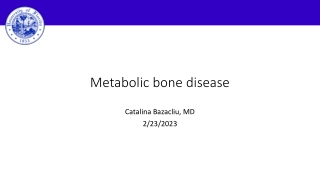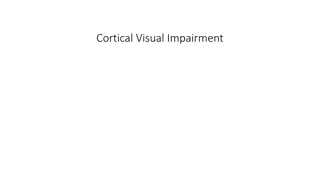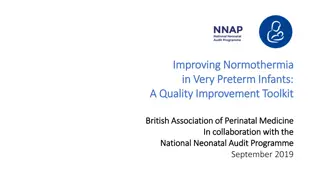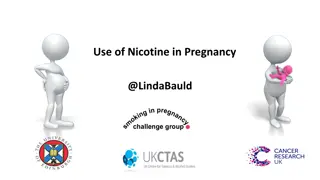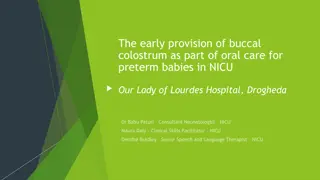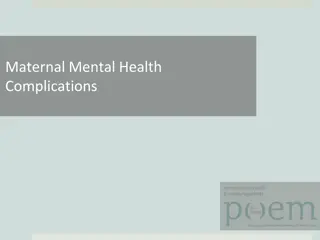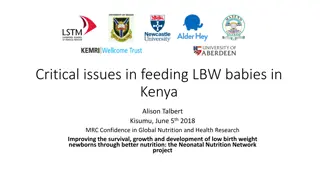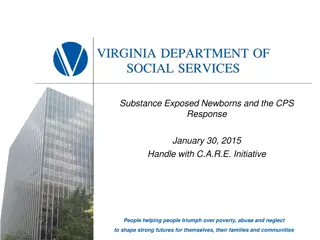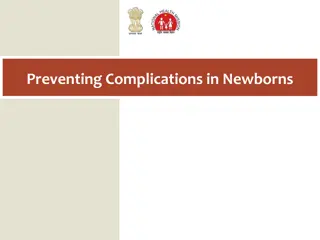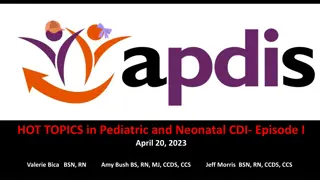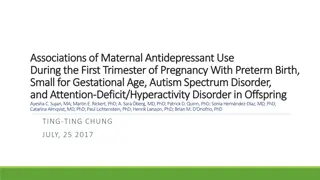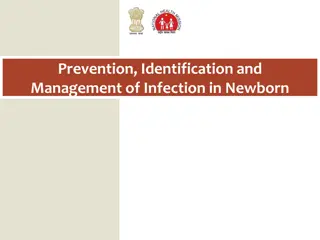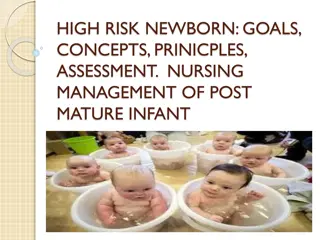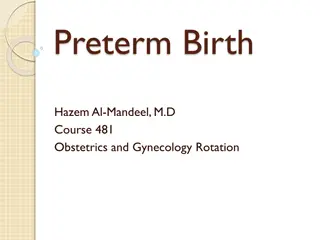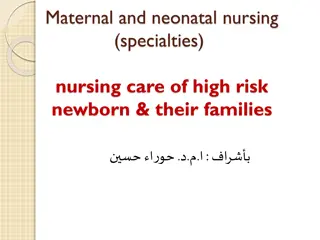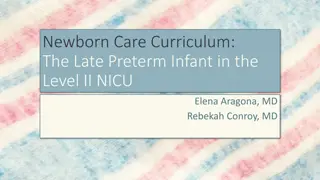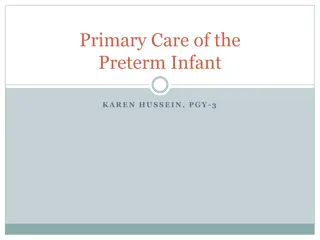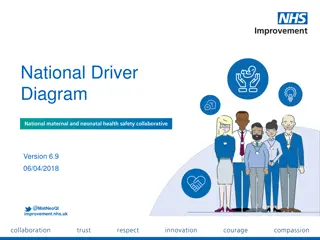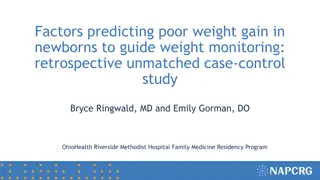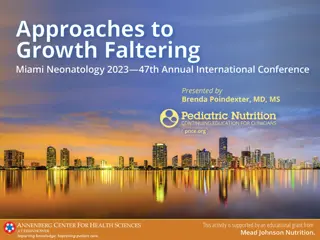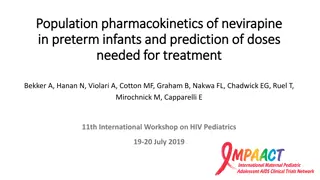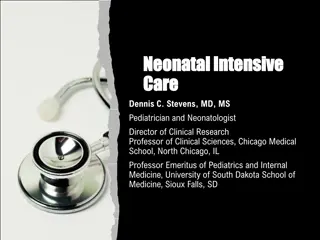Metabolic bone disease
Understand the metabolism of calcium and phosphorus, common disturbances, and nutrient requirements in preterm infants. Learn why metabolic bone disease is important and its long-term effects on bone health.
1 views • 59 slides
Early Intervention Approaches and Research Findings
Explore various approaches and techniques for early intervention, focusing on settings, delivery models, stimulation methods, and caregiver involvement. Discover recent studies on infants born during the pandemic and preterm children's outcomes, emphasizing the importance of language, motor, and cog
1 views • 67 slides
Newborn Screening in Oklahoma
Newborn screening in Oklahoma is crucial for detecting hidden disorders in newborns that may not be apparent at birth. Early detection through screening can lead to timely treatment, ensuring healthy development and potentially saving lives. The process involves testing every newborn for harmful con
1 views • 88 slides
The Organization of NICU: A Comprehensive Guide
The organization of a Neonatal Intensive Care Unit (NICU) plays a vital role in reducing neonatal mortality and improving the quality of life for newborns. This comprehensive guide covers the objectives, definition, basic facilities, levels of care, and components of a NICU. It emphasizes the import
2 views • 60 slides
Cortical Visual Impairment in Infants
Cortical Visual Impairment (CVI) is a condition resulting from retrogeniculate brain damage that affects visual processing in infants. Commonly observed in premature infants, CVI can manifest as atypical behaviors like staring at lights, optic atrophy, and nystagmus. The causes range from structural
3 views • 23 slides
Quality Improvement Toolkit for Improving Normothermia in Very Preterm Infants
This resource provides a comprehensive toolkit developed by the British Association of Perinatal Medicine in collaboration with the National Neonatal Audit Programme to assist clinicians in neonatal units in delivering normothermia to very preterm infants. It includes evidence-based interventions, d
1 views • 17 slides
Preterm Labor and Its Impact on Infant Health
Preterm labor, defined as the delivery of an infant before 37 weeks of gestation, presents risks such as incomplete organ system development and increased infant mortality rates. Unnecessary obstetrical interventions before 38-39 weeks should be avoided. The trends in preterm birth rates reveal disp
0 views • 68 slides
Anesthetic Considerations for Necrotizing Enterocolitis in Neonates
Necrotizing enterocolitis (NEC) is a serious gastrointestinal emergency in neonates, especially those with very low birth weight. Mortality rates are high, and early diagnosis is crucial. Key features, pathophysiology, implications for anesthetic preparation, and diagnostic considerations are discus
3 views • 20 slides
Neonatal Care at Lagos University Teaching Hospital (LUTH)
Lagos University Teaching Hospital (LUTH) is a tertiary referral center providing comprehensive neonatal care services. The facility has specialized units for inborn and outborn babies, offering advanced medical care, including neonatologists, resident doctors, nurses, and support staff. LUTH also h
0 views • 15 slides
Impact of Nicotine Use in Pregnancy: Risks and Consequences
Smoking and nicotine use during pregnancy pose significant risks, including low birth weight, stillbirth, miscarriage, preterm birth, heart defects, and Sudden Infant Death Syndrome. Nicotine Replacement Therapy is licensed for pregnant women but lacks evidence of effectiveness in smoking cessation
1 views • 23 slides
Improving Buccal Colostrum Provision for Preterm Babies in NICU
Early administration of buccal colostrum to preterm babies in the NICU has shown positive outcomes such as improved gut development, reduced infection rates, and enhanced breastfeeding rates. A Quality Improvement program at Our Lady of Lourdes Hospital aimed to provide buccal colostrum within 6 hou
1 views • 5 slides
Detection of Low-Grade Hemorrhages in Preterm Infants: Ultrasounds vs. MRIs
This study compares the effectiveness of head ultrasounds and brain MRIs in detecting low-grade hemorrhages in preterm infants. It discusses the incidence of intraventricular hemorrhage (IVH) in very low birth weight infants, classification of IVH, risk factors for IVH, outcomes related to IVH grade
9 views • 33 slides
Clinical Diagnosis and Assessment of Pre-Labour Rupture of the Membranes
Pre-Labour Rupture of the Membranes (RROM) is characterized by the leakage of amniotic fluid before the onset of labor, particularly when the gestational age is less than 37 weeks. Clinical diagnosis involves a thorough history evaluation and examination, including sterile speculum examination to co
1 views • 18 slides
Preterm Delivery: Causes, Complications, and Evaluation
Preterm delivery, defined as labor prior to 37 weeks of gestation, affects approximately 12% of pregnancies worldwide, with almost 30% of these deliveries occurring before 34 weeks. The etiology of preterm birth can vary from maternal factors such as PROM to fetal anomalies and multiple gestations.
0 views • 25 slides
Premature Rupture of Membranes: Diagnosis and Management Overview
Premature rupture of membranes (PROM) is a complication in pregnancy where the amniotic sac breaks before labor begins. Risk factors include infections and multiple gestations. Diagnosis involves history, physical examinations, and tests like nitrazine and ferning tests. Management depends on gestat
0 views • 7 slides
Cesarean Section and Preterm Labor Risks
Cesarean section (C/S) is a delivery method for various fetal and maternal indications, while preterm labor poses risks like twin pregnancy, uterine abnormalities, and infections. Complications of C-sections and signs of preterm labor are discussed, highlighting the importance of early recognition a
0 views • 9 slides
Maternal Mental Health Complications
Maternal mental health complications, including postpartum depression and psychosis, can have a significant impact on both the mother and child's well-being. Factors such as stigma, culture, trauma, and lack of support systems can exacerbate these conditions. Early detection and intervention are cru
0 views • 12 slides
Overview of Induction of Labour for Obstetric Practice
Induction of labor is the artificial initiation of the labor process before it begins naturally. This procedure is performed in cases such as premature rupture of membranes, prolonged pregnancy, preterm premature rupture of membranes, pre-eclampsia, and maternal medical conditions like diabetes or c
1 views • 30 slides
Challenges in Feeding Low Birth Weight Babies in Kenya
Addressing critical issues in feeding low birth weight babies in Kenya, including the lack of accurate birth weight measurements, preterm birth rates, and the risks associated with formula milk feeding. Strategies such as promoting expressed breastmilk and supporting mothers in neonatal units are di
2 views • 15 slides
Substance-Exposed Newborns and CPS Response
The initiative "Handle with C.A.R.E." aims to help substance-exposed newborns by addressing cases where infants are exposed to controlled substances or alcohol in utero. Health care providers play a key role in identifying such cases within six weeks of birth or at any time post-birth. CPS responses
0 views • 13 slides
Preventing Complications in Newborns: Tips and Strategies
Learn effective ways to prevent common complications in newborns, such as hypothermia, infection, and breathing difficulties. Discover practical tips for maintaining the baby's health and well-being during the crucial early stages, including measures to prevent hypothermia, infection, and breathing
0 views • 6 slides
The Coding Guidelines for Preterm Newborns with Small for Gestational Age (SGA)
Explore the guidelines for coding preterm newborns who are small for gestational age, including birth weight considerations and criteria for assigning appropriate ICD-10 codes. Gain insights into differentiating SGA from low birth weight and effectively documenting neonatal cases.
0 views • 17 slides
Associations of Maternal Antidepressant Use During Pregnancy with Offspring Outcomes
Prenatal antidepressant exposure during the first trimester of pregnancy is linked to various adverse outcomes in offspring, including preterm birth, small for gestational age, autism spectrum disorder, and attention-deficit/hyperactivity disorder. This study evaluates the associations and alternati
0 views • 28 slides
Efficient Baby Screening and Referral Process Overview
Detailed overview of the screening process from sample collection to clinician consultation, including timelines, referral pathways, and confirmation procedures for preterm babies. Lab turnaround times, repeat sample guidelines, and referral process details are also covered.
0 views • 19 slides
Infection Prevention and Management in Newborns
This session focuses on the prevention, identification, and management of infections in newborns, discussing risk factors, infection prevention practices, and the use of antibiotics. Emphasizing the importance of hand hygiene, exclusive breastfeeding, and timely antibiotic use to reduce neonatal sep
0 views • 13 slides
Nursing Management of High-Risk Newborns: Post-Mature Infant Focus
High-risk newborns, including post-mature infants, require specialized care due to their increased chances of morbidity. Identification, goals, assessment, nursing principles, and management strategies are crucial in providing effective care for these vulnerable neonates. Predisposing factors, clini
0 views • 17 slides
Birth Injuries in Newborns
Birth injuries in newborns can result from various factors during the birthing process, such as soft tissue injuries and head trauma. Soft tissue injuries like facial abrasions and scleral hemorrhage may occur due to causes like dystocia and forceps delivery. Nursing care involves assessing and reas
1 views • 19 slides
Preterm Birth: Causes, Diagnosis, and Management
Preterm birth, occurring before 37 weeks of gestation, is a significant concern in obstetrics due to its association with perinatal mortality and morbidity. This article delves into the definition, incidence, etiology, risk factors, diagnosis, and management of preterm labor, providing insights on a
0 views • 8 slides
High-Risk Newborn Nursing Care and Factors
Maternal and neonatal nursing specialties focus on providing care for high-risk newborns and their families, who face conditions endangering the neonate's survival. Factors contributing to high-risk newborns include high-risk pregnancies, maternal medical illnesses like diabetes, labor complications
0 views • 25 slides
Newborn Care Curriculum for Late Preterm Infants in Level II NICU
This curriculum module focuses on the care of late preterm infants in Level II NICU settings, covering topics such as respiratory management, feeding difficulties, hypoglycemia, hypothermia, sepsis, hyperbilirubinemia, and discharge planning. It includes learning objectives, nursery care levels, phy
1 views • 42 slides
Comprehensive Primary Care Guidelines for NICU Graduates
This guide outlines the essential aspects of primary care for preterm infants discharged from the NICU. It covers key topics such as initial visit assessments, follow-up visits, screening protocols, and ongoing management strategies. Emphasis is placed on continuity of care, monitoring growth, addre
0 views • 47 slides
Enhancing Maternal and Neonatal Healthcare Improvements
This initiative aims to improve the safety and outcomes of maternal and neonatal care in England by reducing unwarranted variations, providing high-quality healthcare experiences, and enhancing systems and processes for better care. Key focuses include promoting smoke-free pregnancies, optimizing ca
0 views • 7 slides
Factors Predicting Poor Weight Gain in Newborns: Retrospective Study
A retrospective study aimed to identify characteristics related to poor weight gain in newborns by day of life 14. Factors such as significant weight loss, feeding difficulties, and social determinants of health were found to predict the risk of not regaining birth weight. This study provides insigh
0 views • 7 slides
Neonatal Nutrition: Growth, Nutritional Support, and Management Phases
Neonatal nutrition, specifically focusing on growth faltering and early nutritional support, is crucial for the well-being of premature infants. Understanding growth rates and providing appropriate nutrients are key goals. Target growth rates and reference growth curves are important considerations.
1 views • 28 slides
Population Pharmacokinetics of Nevirapine in Preterm Infants
Population pharmacokinetics of nevirapine in preterm infants were evaluated to predict the doses needed for treatment. Early antiretroviral treatment recommendations for neonates, challenges with available ARV formulations, and the importance of data to inform nevirapine dosing in preterm infants we
1 views • 17 slides
Neonatal Intensive Care Overview by Dr. Dennis C. Stevens, MD
Neonatal Intensive Care (NICU) involves specialized care for preterm and full-term newborn infants with various medical conditions, requiring a multidisciplinary approach. Dr. Dennis C. Stevens, a renowned Pediatrician and Neonatologist, highlights the challenges and importance of NICU care, emphasi
0 views • 22 slides
Neonatology and Hyperbilirubinemia in Newborns
Neonates are at risk of hyperbilirubinemia due to the transition in bilirubin metabolism after birth. Jaundice can lead to Kernicterus, a serious condition affecting brain function when untreated. Understanding the clinical manifestations and risk factors is crucial for early detection and intervent
0 views • 30 slides
Thyroid Function During Pregnancy: Clinical Manifestations and Complications
Changes in thyroid function during pregnancy can lead to clinical manifestations like nervousness, tachycardia, and weight loss. Complications such as abortions, preterm delivery, and thyroid storm can occur. Treatment involves maintaining FT4 levels within the high normal range with medications lik
0 views • 16 slides
Maternal Diabetes and Its Effects on Newborns
Maternal diabetes, whether gestational or pre-existing, can have significant implications for newborns. This comprehensive overview covers the impact of maternal diabetes on infants, including complications, management strategies, prevention of complications, and prognosis. It delves into the pathop
0 views • 24 slides
Neonatal Jaundice
Neonatal jaundice is a common condition in newborns, but severe hyperbilirubinemia can lead to neurological complications if not managed appropriately. This article discusses the risk factors, clinical significance, and management options for hyperbilirubinemia in infants. Recognize the signs, under
0 views • 37 slides
